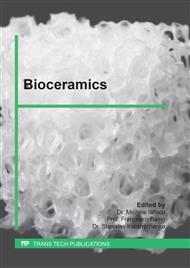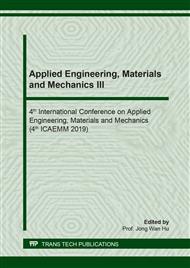[1]
I. Ezekiel, S. R. Kasim, Y.M.B. Ismail, A.F.M. Noor, Nanoemulsion synthesis of carbonated hydroxyapatite nanopowders: effect of variant CO32-/PO43-molar ratios on phase, morphology, and bioactivity, Ceram. Int.44(11) (2018) 13082-13089.
DOI: 10.1016/j.ceramint.2018.04.128
Google Scholar
[2]
Y. Rizkayanti, Y. Yusuf, Effect of temperature on synthesis of hydroxyapatite from cockle shells (Anadara granosa), Int. J. Nanoelectro. Mater. 11 (2018) 43-50.
Google Scholar
[3]
Y. Rizkayanti, Y. Yusuf, Optimization of the temperature synthesis of hydroxyapatite from Indonesian Crab shells, Int. J. Nanoelectro. Mater. 12(1) (2019) 85-92.
Google Scholar
[4]
M. Sari, Y. Yusuf, Synthesis and characterization of hydroxyapatite based on green mussel shells (Perna viridis) with the variation of stirring time using the precipitation method, Int. J. Nanoelectro. Mater. 11(3) (2018) 357-370.
DOI: 10.1088/1757-899x/432/1/012046
Google Scholar
[5]
C. C. Kee, H. Ismail, A.F.M. Noor, Effect of synthesis technique and carbonate content on the crystalinity and morphology of carbonated hydroxyapatite, J. Mater. Sci. Technol. 29(8) (2013) 761-764.
DOI: 10.1016/j.jmst.2013.05.016
Google Scholar
[6]
Y. Doi, Sintered carbonate apatites as bone substitutes, Cells Mater. 7(2) (1993) 111-122.
Google Scholar
[7]
J. P. Lafon, E. Champion, D. Bernache-Assollant, Processing of AB-type carbonated hydroxyapatite Ca10-x(PO4)6-x(CO3) x(OH)2-x-2y(CO3) y ceramics with controlled composition, J. Eur. Ceram. Soc. 28(1) (2008) 139-147.
DOI: 10.1016/j.jeurceramsoc.2007.06.009
Google Scholar
[8]
M. Okada, T. Matsumoto, Synthesis and modification of apatite nanoparticles for use in dental and medical applications, Jpn. Dent. Sci. Rev. 51(4) (2015) 85-95.
DOI: 10.1016/j.jdsr.2015.03.004
Google Scholar
[9]
R. Jayasree, K. Madhumathi, D. Rana, M. Ramalingam, R.P. Nankar, M. Doble, T.S.S. Kumar, Development of egg shell derived carbonated apatite nanocarrier system for drug delivery, J. Nanosci. Nanotechnol. 18(4) (2018) 2318-2324.
DOI: 10.1166/jnn.2018.14377
Google Scholar
[10]
O.F. Kamenetskaya, A. Kol'tsov, M. Kuz'mina, M. Zorina, L. Poritskaya, Ion subtitutions and non-stoichiometry of carbonated apatite-(CaOH) synthesized by precipitated and hydrothermal method, J. Mol. Struct. 992(1-3) (2011) 9-18.
DOI: 10.1016/j.molstruc.2011.02.013
Google Scholar
[11]
S. Cox, Synthesis method of hydroxyapatite, Ceram, University of Birmingham, (2014).
Google Scholar
[12]
M. Fleet, Carbonated Hydroxyapatite: Materials, Synthesis and Application, PanStanforfd Publishing, United States, (2015).
Google Scholar
[13]
Food and Agriculture Organization of the United Nations, Species fact sheets: Cerastoderma edule (Linnaeus, 1758), Fisheries and Aquaculture and Department, (2019).
Google Scholar
[14]
T. Laonapakul, Synthesis of hydroxyapatite from biogenic waste, KKU Eng. J. 42(3) (2015) 269-275.
Google Scholar
[15]
L.G. Ellies, G. A. Nelson, J.D.B. Featherrstone, crystallographic structure and surface morphology of sintered carbonated apatite, J. Biomed. Mater. Res. 22(6) (1988) 541-553.
DOI: 10.1002/jbm.820220609
Google Scholar
[16]
T.I. Ivanova, O.V.F Kamenetskaya, A. B. Kol'tsov, V.L. Ugolkov, Crystal structure of calcium-deficient carbonated hydroxyapatite: Thermal decomposition, J. Solid State Chem. 160(2) (2001) 340-349.
DOI: 10.1006/jssc.2000.9238
Google Scholar
[17]
Q. Liu, J.P. Matinlinna, Z. Chen, C. Ning, G. Ni, H. Pan, B.W. Darvell, Effect of thermal treatment on carbonated hyroxyapatite: morphology, composition, crystal characteristics and solubility, Ceram. Int. 41(5) (2015) 6149-6157.
DOI: 10.1016/j.ceramint.2014.11.062
Google Scholar
[18]
A. Slosarczyk, Z. Paszkiewicz, A. Zima, The effect of phosphate source on the sintering of carbonate subtituted hydroxyapatite, Ceram. Int.36(2) (2010) 577-582.
DOI: 10.1016/j.ceramint.2009.09.032
Google Scholar
[19]
M. F. Toney, XRD. Encyclopedia of Materials Characterization, (1992) 198–213.
Google Scholar
[20]
D. Núñez, E. Elgueta, K. Varaprasad, P. Oyarzún, Hydroxyapatite nanocrystals synthesized from calcium rich bio-wastes, Mater.Lett. 230 (2018) 64-68.
DOI: 10.1016/j.matlet.2018.07.077
Google Scholar
[21]
E. Landi, A. Tampieri, G. Celotti, L. Vichi, M. Sandri, Influence of synthesis and sintering parameters on the characteristics of carbonate apatite, Biomaterials, 25(10) (2004) 1763-1770.
DOI: 10.1016/j.biomaterials.2003.08.026
Google Scholar
[22]
R. Z. LeGeros, R. Kukowska, C. Bautista, J.P. Le Geros, Synergistic effects of magnesium and carbonate on properties of biological and synthetic apatites, Connect Tissue Res. 33(1-3) (1995) 203-209.
DOI: 10.3109/03008209509017003
Google Scholar



